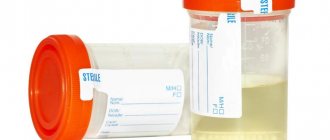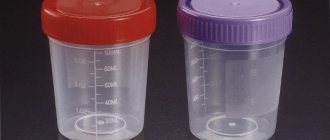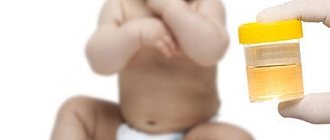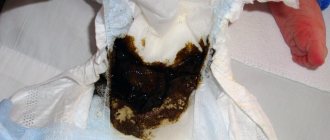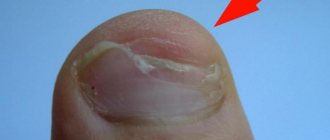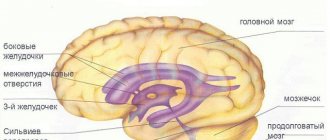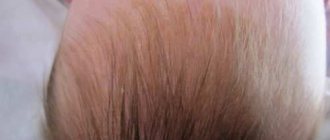Basic parameters of the norm
A healthy baby produces urine that is light yellow in color and without any odor. Urine begins to smell as you age. Normally the odor is faint. A sharp, distinct smell of urine indicates increased acetone, diabetes mellitus, or the presence of bacterial flora in the bladder.
Normally, urine foams, but quickly returns to its normal state. Light, pink, yellow urine in a newborn should in any case be transparent. Turbidity can only appear if the biomaterial is stored for a long time. A newborn's urine without impurities is normal.
Interpretation of urine in infants by color and smell
Color
The color of a newborn's urine can vary from light yellow to dark amber. In the first days of life, urine may be light, but if the volume of fluid consumed is small, then we can talk about a high concentration, especially if the color has changed to a darker shade. Such urine can irritate the baby's delicate skin due to its high salt content. As a result, leaving a baby without diapers turns out to be dangerous, especially if the diaper is not changed immediately.
If the color has a pronounced yellow color for a long time, then this indicates kidney and liver disease. Problems in the biliary system can only be detected by the presence of bilirubin in the baby’s urine, for which appropriate laboratory tests are performed.
The alarm should not be raised when vegetable products in the form of carrots and beets are introduced to the baby as complementary foods. After dinner with vegetable puree, you can already expect a change in the color of the baby’s urine.
The rich color of a baby's urine indicates its high concentration, which is caused by a lack of fluid intake, an acute intestinal infection, or a high salt content.
Smell
Normal for a baby is a faint odor of the secreted fluid without any side impurities. If the smell gives off the characteristic aroma of rotten apples, this indicates an increased content of acetone in the urine. It is necessary to carry out all tests to identify the cause of the formation of this substance.
Ketone bodies that affect the formation of acetone appear due to:
- constipation;
- intoxication through the use of medications or drugs prohibited for the baby;
- gastritis;
- strong physical activity, which also occurs in infants;
- changing foods that are poorly absorbed by the body;
- body infections;
- hypothermia;
- agitation or constant fatigue, which is facilitated by disturbances in the body.
The smell of ammonia in the urine of a newborn indicates cystitis. Bacteria decompose urine already in the bladder and an inflammatory process occurs, which can only be treated with medication.
If the color of the liquid secreted by the baby is not suitable for immediate contact with a specialist, then the smell is a direct route to all laboratory tests. The smell of acetone may indicate the development of diabetes mellitus in a child, and the smell of ammonia may indicate the presence of a malignant tumor.
Examination of a child’s urine according to indicators
Every parent should be aware of the basic indicators provided by a urine test. The following table shows the main parameters by which urine is studied. A transcript of each of them is also attached.
| Parameter | Norm | Deviation |
| Protein | Normally there is no protein or no more than 0.08 | A large amount of protein indicates inflammatory reactions. Urination becomes painful, the boy or girl complains of general discomfort. The color of urine can be light, but it is always cloudy |
| Glucose | 0 | In the first days of life, the child may urinate urine with a high sugar content. But as you get older, your glucose levels should drop to zero. |
| Bilirubin | 0 | If a child has bilirubin in the urine, this indicator may indicate problems with the kidneys and urinary tract. The urine color may be clear or pink. |
| Ketone bodies (ammonia, acetone) | 0 | A high level indicates problems with metabolic status, indicating diabetes mellitus and liver pathologies |
| Leukocytes | No more than 5 in sight | The more leukocytes, the stronger the inflammatory process |
| Red blood cells | Not 2 in sight | Red blood cells in large numbers indicate poisoning with toxins, hyperthermia, or viral disease. Blood in urine can occur due to any infection |
| Cylindrical bodies | 0 | The presence of casts indicates an infection in the body |
Video: How to easily collect urine for analysis from a child
How to easily collect urine for analysis from a child. © Shilova Natalia.
What does the color of a baby's urine indicate?
All cases of changes in the color, smell, quantity and transparency of the baby's urine require an immediate visit to the pediatrician. Inflammatory processes in newborns develop rapidly, and this fluid indicates the presence of pathology very clearly.
Changed urine color in an infant may indicate the presence of the following diseases:
- Dark yellow color – the presence of increased content of bile pigments in the urine. Possible liver infection.
- Orange color – high content of oxalate salts or lack of fluid in the body, high fever, diarrhea or vomiting.
- Red color – increased content of erythrocytes (red blood cells). May indicate kidney and urinary tract disease.
- A greenish tint is caused by obstructive jaundice in a newborn.
In each of these cases, it is necessary to urgently consult a doctor and begin treatment. The transparency of urine indicates whether there is inflammation in the child’s body and the presence of salts in it: phosphates or oxalates. If the urine is cloudy, it means the child has health problems.
Salts in urine
Salts in a baby’s urine indicate an error in nutrition:
- When introducing complementary foods, excess salt often appears, especially if you feed the child meat broths, fatty fish and meats, eggs and other animal products.
- Diseases of the gastrointestinal tract - gastritis, stomach ulcers, diseases of the kidneys and biliary tract increase the salt content in the urine, which leads to the formation of sand and, subsequently, to urolithiasis.
If you notice a change in color and transparency in a child, you should contact a pediatrician, because the increased salt content in an infant can lead to dangerous consequences in the form of intoxication, leukemia, diathesis, gout, fever, ulcerative colitis, cystitis, pyelonephritis, hyperparathyoresis, Fanconi syndrome. As soon as a diagnosis is made, the salt content in the infant’s urine should be reduced to avoid further development of the disease.
"Brown Dust"
Concentrated urine in the first days of life may contain uric acid crystals. They stand out on the diaper as a dusty spot of pink, orange or red hue and are called “brown dust” in medical terminology. This may alarm parents, but such phenomena are considered normal and occur in many newborns.
On the 5th-6th day, the baby’s urine ceases to be concentrated, because the baby receives enough breast milk, and at the same time water. But even in this case, you may occasionally notice a dark spot of concentrated urine on the diaper - this is also normal.
If such a spot appears too often, you should immediately contact your pediatrician. If a child urinates concentrated urine in small volumes after the 4th day of life, this indicates a lack of nutrition, which also causes weight loss in the child. Specialists should check the baby’s health and breastfeeding technique. Proper nutrition will quickly eliminate the problem of concentrated urine.
It is important to know that the color, smell, frequency of urination and its volume are indicators of the health of the little man. Parents should not hush up the problem of changes in normal urine levels in a child. Timely treatment and proper treatment, or maybe just caring for the baby, will help quickly eliminate the problem and help the baby become cheerful and healthy.
www.rebenokdogoda.ru
What affects the color of urine
Urination and urine parameters return to normal only 10 days after birth. If a month-old baby has difficulty peeing, and his urine takes on an unusual color, you should pay attention to this. The table shows the main variations in urine color.

| Urine shade | Probable Causes |
| Dark orange | High concentration of urine associated with a lack of moisture in the body. Orange blossom can be caused by too many carrots in the diet |
| Brown, green | Sign of obstructive jaundice or increasing hemolytic anemia |
| Red "dirty" | Indicates that there is blood in the urine. Causes: porphyria, hemolytic crisis. In older children - glomerulonephritis |
| Blue undertone | Indicates rot in the intestines |
| Black color | Advanced hemolytic anemia, melanoma, melanosarcoma |
| Pink | The body contains phenolphthalein |
| Greenish | Pus turns urine of any basic shade green |
Reasons for changes in urine color
The most common explanation for why urine is bright yellow is because it is highly concentrated. This is explained by the following factors:
Causes of urine color change
- improper use of liquid, namely: in small quantities;
- high physical activity and low drinking volume;
- acute intestinal infections and other poisonings accompanied by vomiting, diarrhea and profuse sweating;
- diseases that lead to the formation of edema;
- use of laxatives and diuretics;
- infectious diseases that affect the liver;
- high content of oxalate salts in the urine;
- viral diseases that are accompanied by profuse sweating;
- diseases accompanied by increased breakdown of hemoglobin;
- use of certain medications;
- congestion in the kidneys;
- pathology of the biliary tract.
When a small amount of water enters a child’s body, intense reabsorption of water occurs in the kidney system. As a result, urine becomes concentrated due to its small amount, so it acquires a too intense yellow color. That is why a child must be taught from a very young age to drink water, and not just teas and juices.
For the same reason, the color of the urinary fluid changes to a more intense one during physical exertion, as well as with profuse sweating. This could be a situation that involves an infectious disease, such as influenza. Against the background of high body temperature, a large amount of fluid is lost. In the absence of its compensation, dehydration occurs in the body. It is important to know that parents should provide water to a child with a high body temperature.

Adequate fluid intake is a step in preventing bright yellow urine.
Intestinal infections are also common causes of abnormal urinary fluid. Indeed, in addition to sweating, fluid loss also occurs due to diarrhea and vomiting.
It often happens that children have problems with bowel movements, and adults prescribe laxatives to children without the recommendation of a doctor. So, it is these drugs that can provoke bright yellow urine in a child. It is necessary to understand that most laxatives are prohibited for children. Lactulose is relatively safe, however, its use should be agreed with a doctor.
Unfortunately, infectious liver diseases in the little ones should not be overlooked. We are talking about hepatitis of a viral nature. In newborns, it most often has a placental nature, i.e. infection occurs through the mother's placenta.
Common symptoms for this infection are yellowness of the sclera and visible mucous membranes, as well as the skin, weakness, drowsiness of the child, and a high temperature may be present. And, of course, urine takes on a yellow tint.
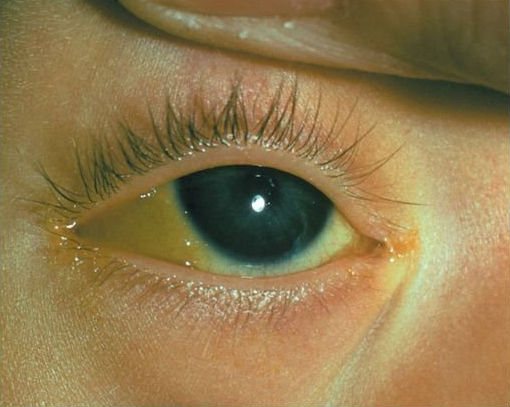
Sclera of a child with viral hepatitis C
As for taking medications and vitamin complexes, it’s worth saying right away that they very often provoke the appearance of a yellow color in the urinary fluid. Of the antibacterial drugs, it is worth noting the nitrofuran group - Rifampicin. Of the vitamins, A and C, as well as B vitamins, have this ability.
An important group of factors leading to the pathology discussed in this article are diseases that are accompanied by intense death of red blood cells. Among them are hemolytic, sickle cell anemia, thalassemia, Gilbert's disease.
Gilbert's disease usually manifests itself in children from the age of five; it manifests itself in the fact that the child develops diffuse jaundice and is characterized by the appearance of granulation on the upper eyelid, the so-called xanthelasma. And of course, the urine turns bright yellow.
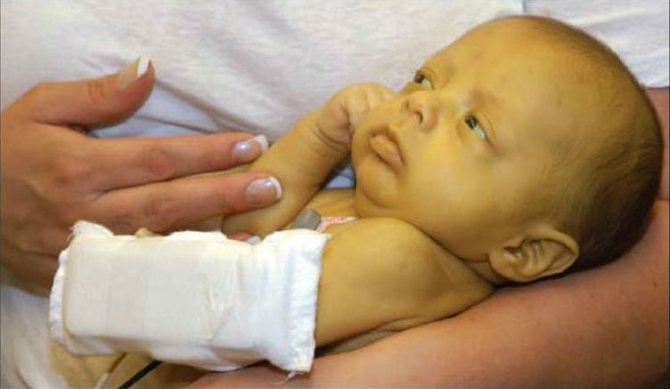
A child suffering from hemolytic anemia (the figure clearly shows the yellowness of the skin)
With hemolytic anemia, against the background of high destruction of red blood cells, the urine contains a large amount of pigmenting substances, it becomes yellow. In addition to this symptom, jaundice, pain in the left hypochondrium and an enlarged spleen are characteristic.
Urolithiasis in children is rare, but it can also cause the problem under discussion; the main clinical manifestation of this pathology is renal colic. It starts in the lower back and spreads to the abdomen and groin area. Possible fever and blood in the urine.
Urine color and nutrition

However, it is the baby’s diet that can slightly adjust the main indicators. Bright yellowish color of urine can occur in children who actively consume foods with dyes. This is typical for children older than 2 years. Pumpkin, carrots, beets, and currants give urine a specific yellowish tone. If these products are included in complementary foods, the baby is given juices, teas and decoctions with “natural dyes”, the urine may change its color. Yellow urine in a baby can only be because the child’s diet is not entirely correct.
Change in urine color in a child
The color of urine in newborns can range from yellow to deep straw. In children, its shade may also indicate various symptoms of disease, but this is not necessary. Very often, bright yellow urine in a child indicates an insufficient amount of fluid in the body.
If your baby’s urine has a bright yellow color for a long time or has completely changed color, it is better to play it safe and visit a pediatrician so as not to cause harm and not cause the disease. Color changes in the fluid leaving the kidneys in children mean the same diseases as in adults.
Special reasons
A newborn's urine changes as the baby adapts to new living conditions. From the moment complementary foods are introduced, it will also change, due to the same adaptation mechanisms. At about 1 year old, the baby no longer depends on outside influences, and deviations indicate specific health problems.
The urine of a month-old and newborn baby may also change for the following reasons:
- Fluid deficiency;
- High physical activity;
- Infections;
- A large amount of a specific product in the diet (fish, carrots, beets, pumpkin, currants)
- Pathologies causing swelling;
- Liver pathologies (they may occur as the baby grows older, or the child may be born with the disease);
- Viruses complicated by intense sweating;
- Hemoglobin breakdown;
- Kidney congestion;
- Systemic pathologies (the entire body suffers from joints to muscle tissue);
- Bladder abnormalities;
- Hypervitaminosis (any vitamin in excess can change the color of urine, even banal ascorbic acid).
What causes urine color to change?
There are quite a few reasons why urine turns into one color or another. It is affected by metabolism, the amount of metabolites, and the volume of fluid excreted. In children, the color of urine depends on age. For example, in a newly born baby it will be almost colorless, and in the first few weeks a reddish tint is possible. Infants pee with a light yellow liquid. An older child's urine is different from that of an adult; it is much lighter.
Products can also change the color of fluid excreted from the body. Carrots make it orange, beets pink or red, asparagus green. And these are not all vegetables that are capable of staining urine. When the urine changes color during the treatment period, then this is the effect of the drugs. This property is always indicated in the instructions. Regular vitamins often make urine bright yellow.
But in most cases, such changes can characterize pathological processes and diseases in the body. Each color means a different disease:
- Dark yellow urine comes out as a result of burns or dehydration. It may also indicate an infectious disease and congestion in the kidneys;
- lack of color is a sign of diabetes mellitus, kidney failure;
- almost black urine is possible with alkaptonuria or malnosarcoma;
- red color indicates blood has entered the urine. This phenomenon occurs with tumors of the urinary system, kidney infarction or urolithiasis;
- when jaundice activates, it may change to a green-yellow color;
- the formation of kidney stones can cause yellow urine with sediment;
- the liver and gall bladder “scream” about their illness through brown discharge from the kidneys;
- urine mixed with flakes indicates cystitis, urethritis, and kidney inflammation.
What should parents do?
If the urine has become an intense yellow color, you need to pay attention to the child’s menu and adjust his drinking regime.
You should visit a doctor if the color has changed radically, and the smell of urine has become downright unpleasant and very pronounced. During the examination, the doctor will decide which tests to take. The standard set is a general blood and urine test, Nechiporenko analysis, urine test for sugar and detailed biochemistry. Biological material is collected only in the morning.
Further treatment tactics and prognosis for the future will depend on the diagnosis, the age of the child, and the individual characteristics of the baby. As a rule, correct timely treatment will allow the little patient to return to normal life.
Video: The best feeding regimen for a newborn
The best feeding regimen for a newborn - Dr. Komarovsky


